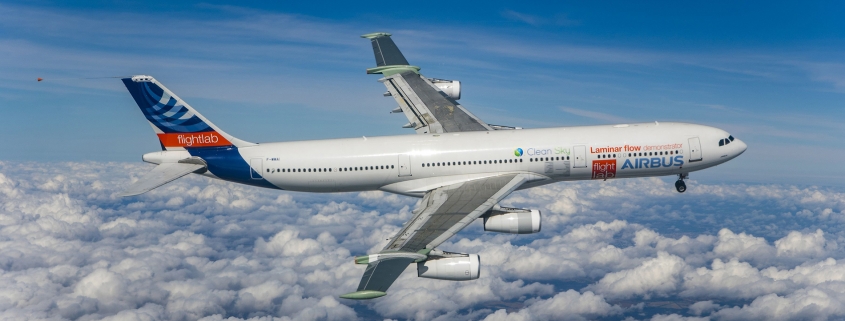The A340 ‘Flight Lab’ BLADE was recently showcased for the first time at the ILA Air Show in Berlin. It is the world’s first demonstrator aircraft equipped with a laminar wing. The innovative wing reduces drag and thus fuel consumption and lowers harmful emissions like CO2. The wing was developed within the SFWA (Smart Fixed Wing Aircraft) Platform , part of the EU’s Clean Sky programme, aimed at making European aviation sustainable. NLR and DNW are both participating in the project and as a gesture of appreciation the two organisations were allowed to put their signatures on the fuselage of the demonstrator aircraft.
BLADE stands for ‘Breakthrough Laminar Aircraft Demonstrator in Europe’. The A340 ‘Flight Lab’ BLADE was developed from an A340-300 MSN001 test aircraft, with the outboard wings replaced by laminar wings. The special, more precise form of a laminar wing allows air to flow across the wing for a longer time without turbulence and thus reduces drag. One of the challenges was to construct an extremely smooth surface without any cavities or other unevenness.
Michel Peters (NLR) and Christophe Hermans (DNA) placing their signature on the A340 ‘Flight Lab BLADE’
In various ways NLR and DNW played a role in developing the BLADE wing. NLR was involved on account of its knowledge of advanced measuring methods.. A scale model of the BLADE demonstrator aircraft was tested in the DNW-LLF low-speed wind tunnel, with an emphasis on aircraft handling qualities during take-off and landing. The successful wind tunnel tests were instrumental in the flight release for the A340 ‘Flight Lab’ with BLADE wings.
NLR has been involved in several SFWA work packages since 2008, because of its multidisciplinary knowledge of aerospace technology and its testing facilities. Among other things NLR supported Dutch industry in developing wing flaps and tails for business planes of Dassault Aviation and in innovating in cabling. NLR also cooperated with Airbus in the fields of loads control (controlling the forces exerted on a wing), the contra-rotating open rotor and flight test instrumentation. In the case of instrumentation, NLR’s involvement included a proposal of an alternative method for measuring the in-flight wing distortion of BLADE wings.
See also:
http://cleansky.eu/http://www.cleansky.eu/
http://www.cleansky.eu/smart-fixed-wing-aircraft-sfwa
 This research was funded from the EU’s Clean Sky Programme, but neither the report nor this press release necessarily reflects the views of the European Commission.
This research was funded from the EU’s Clean Sky Programme, but neither the report nor this press release necessarily reflects the views of the European Commission.

 © Airbus - Sylvain Ramadier
© Airbus - Sylvain Ramadier

 NLR - Netherlands Aerospace Centre
NLR - Netherlands Aerospace Centre